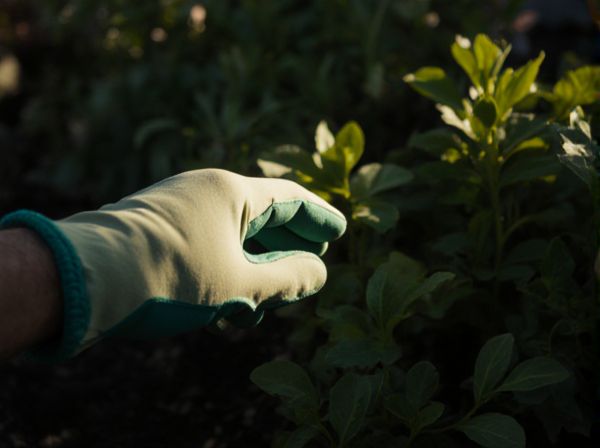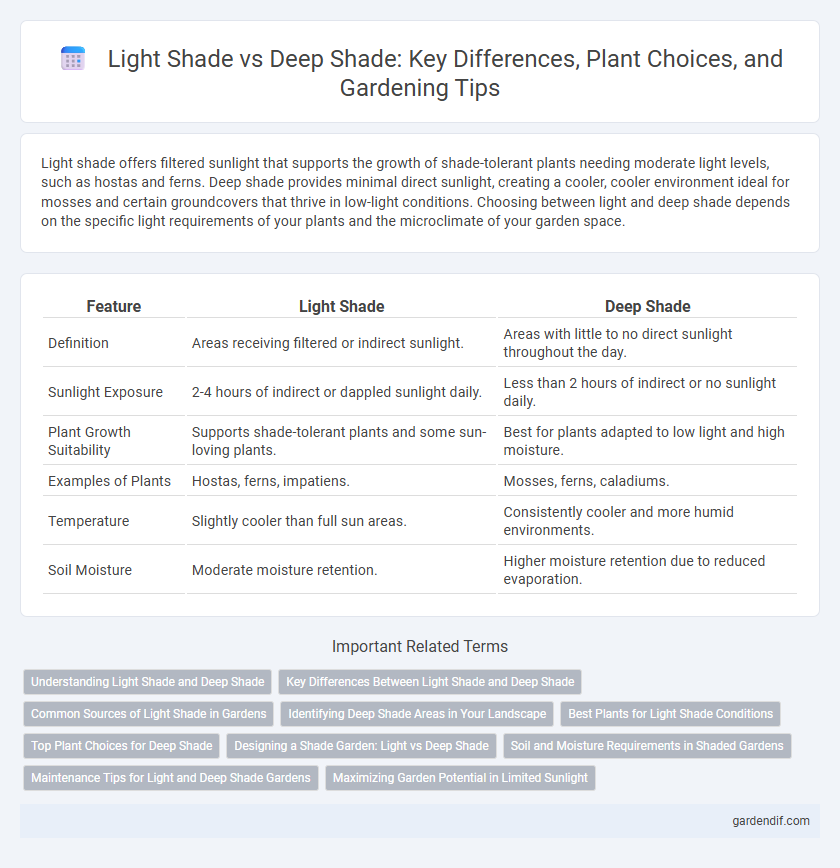
Light Shade vs Deep Shade Illustration
Light shade offers filtered sunlight that supports the growth of shade-tolerant plants needing moderate light levels, such as hostas and ferns. Deep shade provides minimal direct sunlight, creating a cooler, cooler environment ideal for mosses and certain groundcovers that thrive in low-light conditions. Choosing between light and deep shade depends on the specific light requirements of your plants and the microclimate of your garden space.
Table of Comparison
| Feature | Light Shade | Deep Shade |
|---|---|---|
| Definition | Areas receiving filtered or indirect sunlight. | Areas with little to no direct sunlight throughout the day. |
| Sunlight Exposure | 2-4 hours of indirect or dappled sunlight daily. | Less than 2 hours of indirect or no sunlight daily. |
| Plant Growth Suitability | Supports shade-tolerant plants and some sun-loving plants. | Best for plants adapted to low light and high moisture. |
| Examples of Plants | Hostas, ferns, impatiens. | Mosses, ferns, caladiums. |
| Temperature | Slightly cooler than full sun areas. | Consistently cooler and more humid environments. |
| Soil Moisture | Moderate moisture retention. | Higher moisture retention due to reduced evaporation. |
Understanding Light Shade and Deep Shade
Light shade refers to areas that receive filtered sunlight or dappled light for several hours a day, ideal for plants that need moderate light without direct sun exposure. Deep shade describes locations with little to no direct sunlight, often beneath dense tree canopies or on the north side of buildings, where only indirect or reflected light is available. Understanding the difference between light and deep shade is crucial for selecting suitable plants and designing garden spaces that thrive under specific light conditions.
Key Differences Between Light Shade and Deep Shade
Light shade occurs in areas receiving indirect sunlight for part of the day, fostering growth for shade-tolerant plants like ferns and impatiens that need moderate light. Deep shade is characterized by minimal to no direct sunlight, commonly found beneath dense tree canopies, favoring plants adapted to low-light conditions such as hostas and mosses. The key difference lies in light intensity and duration, where light shade supports a broader range of understory vegetation due to available ambient light, while deep shade restricts plant diversity to species highly adapted to darkness.
Common Sources of Light Shade in Gardens
Common sources of light shade in gardens include deciduous trees, tall shrubs, and pergolas with slatted roofs that filter sunlight, creating a dappled effect ideal for shade-tolerant plants. Structures such as fences or lattice panels combined with climbing vines also produce light shade by partially blocking direct sunlight while allowing sufficient illumination. Gardens with nearby buildings or walls can cast soft shadows during certain times of day, contributing to patches of light shade that support delicate foliage and shade-loving flowers.
Identifying Deep Shade Areas in Your Landscape
Deep shade areas in your landscape are typically located beneath dense tree canopies, large shrubs, or structures that block over 80% of direct sunlight throughout the day. Identifying these zones involves observing consistent lack of sunlight, cool soil temperatures, and limited plant growth, which distinguish them from lighter shaded regions receiving some dappled sun. Mapping out deep shade helps in selecting shade-tolerant plants like ferns, hostas, or mosses that thrive under persistent low-light conditions.
Best Plants for Light Shade Conditions
Best plants for light shade conditions include hostas, ferns, and astilbes, which thrive with filtered sunlight and partial exposure. These species tolerate indirect light while maintaining vibrant foliage and blooming capacity. Choosing plants adapted to light shade ensures healthy growth and garden aesthetics in areas with dappled sunlight or morning sun.
Top Plant Choices for Deep Shade
Top plant choices for deep shade thrive with minimal sunlight and include species such as hostas, ferns, and astilbes. These plants exhibit strong shade tolerance due to their ability to photosynthesize efficiently under low-light conditions. Selecting deep shade plants with broad leaves and robust root systems maximizes growth potential in densely shaded garden areas.
Designing a Shade Garden: Light vs Deep Shade
Designing a shade garden requires understanding the differences between light shade and deep shade to select appropriate plants that thrive in varying light levels. Light shade areas receive filtered sunlight or dappled shade, ideal for hostas, ferns, and astilbes, which need moderate light to photosynthesize effectively. Deep shade zones, characterized by minimal to no direct sunlight, support shade-tolerant species like heuchera, bleeding hearts, and certain varieties of ivy that adapt to low-light conditions while maintaining vibrant foliage.
Soil and Moisture Requirements in Shaded Gardens
Light shade areas typically feature well-drained soil with moderate moisture, supporting plants that need partial sunlight and consistent hydration. Deep shade environments often have richer, moisture-retentive soil due to less evaporation and dense canopy cover, ideal for shade-loving species requiring high soil moisture. Understanding soil composition and moisture retention under different shade intensities ensures healthier plant growth and sustainable garden care.
Maintenance Tips for Light and Deep Shade Gardens
Light shade gardens benefit from regular watering to prevent soil drying and periodic pruning to promote airflow and reduce disease risks. Deep shade gardens require mulch layers to retain moisture and enrich soil nutrients while selecting shade-tolerant plants such as ferns and hostas for low-maintenance growth. Both garden types should have soil tested seasonally to adjust fertilization practices that support healthy plant development.
Maximizing Garden Potential in Limited Sunlight
Light shade provides filtered sunlight that supports the growth of diverse shade-tolerant plants including ferns, hostas, and astilbes, maximizing garden potential by enhancing foliage texture and color. Deep shade environments limit photosynthesis, favoring mosses, certain ferns, and evergreen ground covers that thrive in low-light conditions while reducing competition for nutrients. Strategic plant selection and soil enrichment optimize growth, ensuring a vibrant garden even with limited direct sunlight.
Light Shade vs Deep Shade Infographic

 gardendif.com
gardendif.com